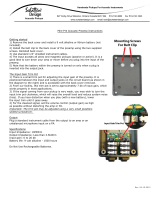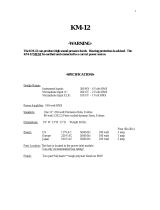
PAGE 2
Overview
The STRATEGY begins with BRIGHT, NORMAL and ACTIVE INPUT Select choices feeding an all-new tube
preamp that borrows subsections from our CARBINE hybrid architecture. This preamp design allows increased control over a broad
spectrum of frequencies and incorporates active BASS and TREBLE controls with increased shaping power—while retaining the
sweet, musical blend of our traditional passive MID control. In addition to these we’ve included a reworked-for-tubes version of the
CARBINE’s 5-position rotary VOICE feature that allows notching or enhancement of specific midrange regions in addition to bass
and treble frequency boosting. The VOICE feature puts you instantly in iconic stylistic realms—from elastic, mid-scooped Thumbing to
articulate, mid-flat Fingerstyle, to the Classic metallic, scooped American Pick sound—with a flick of a switch. The ability to jump right
to these classic “curves” makes re-voicing on the fly in performance situations a snap, is also footswitchable, and adds immensely to
the STRATEGY’s versatility.
Your new amplifier has an update to the original feature set. The GAIN control now includes a PULL BOOST function that increases
the gain in the preamp and creates a region of tube saturation at the upper end of the control’s taper.
This boost in gain created when the GAIN control is pulled fattens up the sound, adds natural tube saturation and compresses the
attack. The higher the GAIN control is set, the more these characteristics become dominant in the mix. For maximum overdrive
levels, set the GAIN Control in the upper region of its sweep (3:00 – 5:30).
In addition to the effective and superbly musical shaping power of the STRATEGY preamp, the 9-Band Graphic Equalizer is included
for accurate fine-tuning once you’ve dialed in a sound style with the Tone Controls and VOICE Feature. This inductor-based circuit is
a tried and true, yet expanded carry-over from the BASS 400+ and has been an integral part of both our Guitar and Bass amplifiers
for well over 40 years. The EQ is controlled by a mini toggle on the Front Panel and allows you to bring it on-line manually, via the EQ
button of the optional STRATEGY Footswitch, or a single-button footswitch in the EQ ON/OFF Switchjack on the back of the amp.
Control over the Tone would be incomplete—at least in our minds—without control over the power as well. So the STRATEGY gives
you three choices as to how to utilize the power section. As wattage ratings are often misleading and irrelevant to volume when it
comes to describing tube power, the STRATEGY offers FULL, HALF and LOW power settings on the MULTI-WATT™ switch. Each
of these choices has a distinct tonal color and persona, with FULL delivering the maximum punch, authority and headroom. HALF
can deliver some valuable and surprising mid to lower power applications for tube-driven Bass while still offering plenty of volume for
a lot of live situations. LOW opens up many stylistic possibilities in the recording domain and may also work for some lower volume
gigs. An important collection of vintage-inspired sounds await you here in HALF and LOW POWER ranging from round and warm,
to edgy, to clipped and growling—depending how you dish it out from the MASTER. All the sounds in HALF and LOW POWER beg
to be recorded.
A MUTE/PLAY/SILENT RECORD switch allows convenient Front Panel muting for instrument changes, silent tuning or recording, or
any time where signal muting is needed. An AUTO-MUTE circuit is fitted to the Speaker Jacks to protect the transformer and power
tubes if no speaker is connected and is indicated by the same Front Panel LED triggered by the mini-toggle MUTE/PLAY/SILENT
RECORD switch (Red LED ON = MUTE). The SILENT RECORD setting allows you to safely mute the signal at the Power Amp and
use the STRATEGY preamp (including processing in the FX LOOP) to record using the D.I. OUTPUT without sound from the speaker.
The Rear Panel D.I. OUTPUT signal can be derived from either PRE (your instrument) or POST (the entire preamp) with the Front
Panel D.I. Switch. The D.I. OUTPUT signal strength is controlled by the Front Panel D.I. LEVEL located at the far right side of the
Chassis next to the SOLO™ Control
The STRATEGY incorporates our SOLO™ feature that has become so popular on our guitar amplifiers, which gives you a pre-settable
and footswitchable boost for any time you want to feature a specific part or featured solo in a song. The SOLO control can also be
used to compensate for EQ settings where several frequencies are cut creating a drop in overall volume or for an instrument with a
lower output due to weaker pickups.
Jumping to the Rear Panel you are greeted with the AC Receptacle. Use the supplied IEC removable 3 prong AC Cable and connect
the female end here.
The four EXTERNAL SWITCH jacks make the STRATEGY compatible with virtually any switching system’s architecture. These pro-























